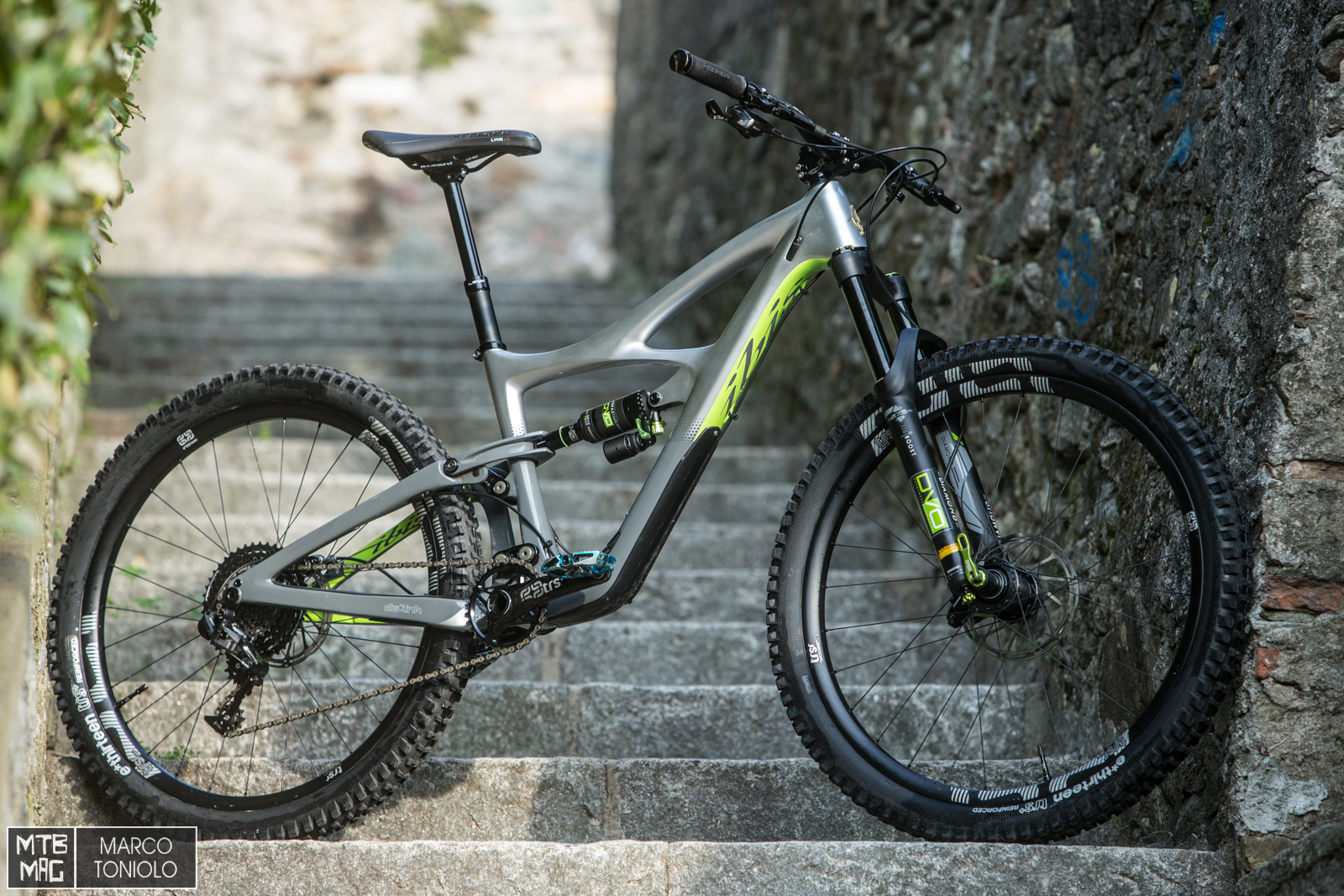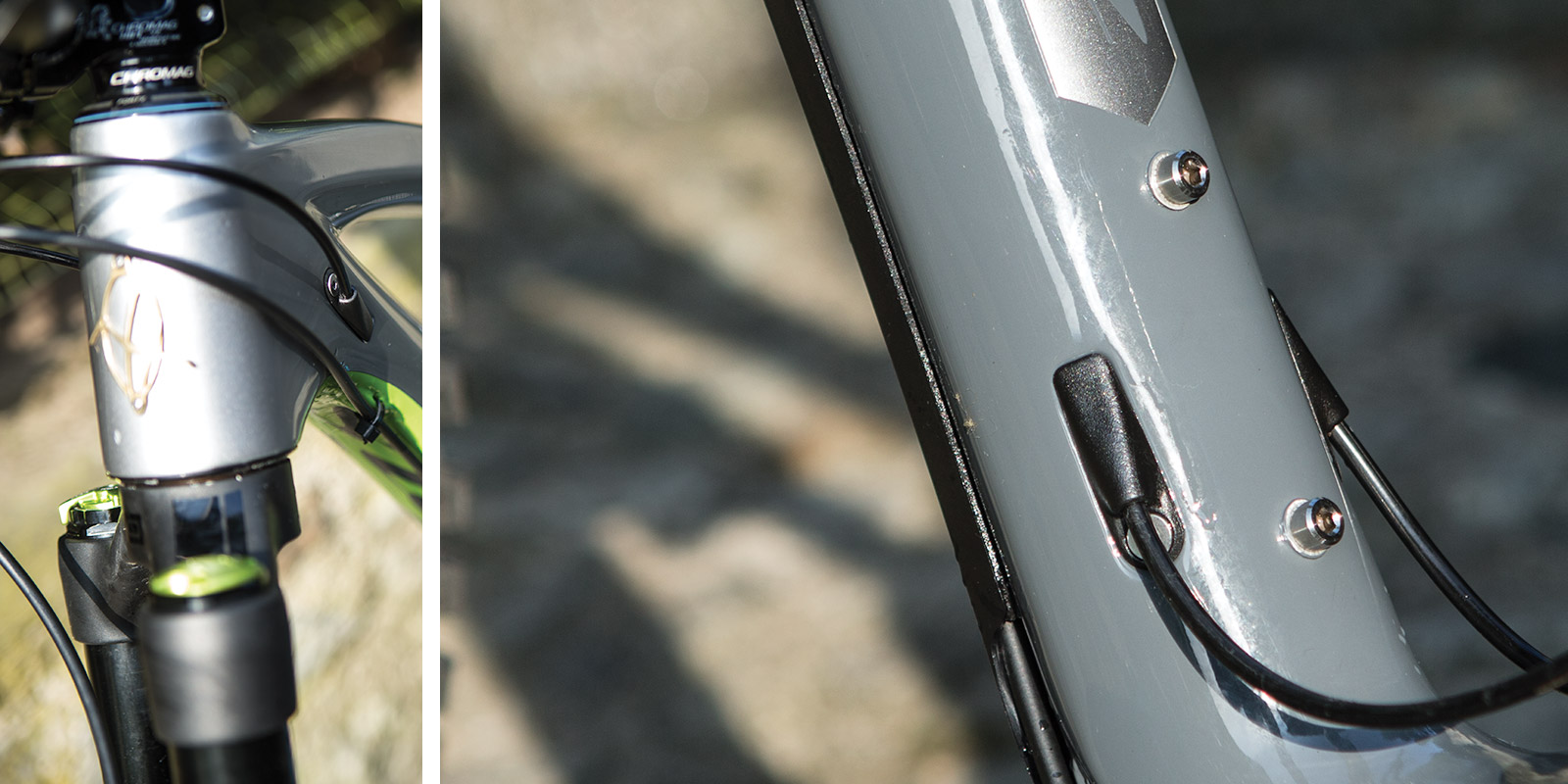[Tested] Ibis Mojo HD4 Team Replica
At the end of May 2017 Ibis showcased the new Mojo HD4, an Enduro bike with 27.5” wheels. In contrast with the previous model, the Californian brand this time followed the Enduro trend towards longer and slacker geometry. In fact, the head angle is 64.9° and the reach is longer on all sizes. The Boost standard is a must, of course.
The tested build was supplied by the Italian distributor 4Guimp, and, apart from wheels and tires – it is identical to the bikes raced by the CMC Ibis Team in the 2017 season during the EWS.

Mojo HD4 Team Replica highlights
Frame: full carbon
Wheels format: 27.5”
Suspension scheme: DW Link
Adjustable geometry: no
Front/rear travel: 160/150 mm
Rear Boost: yes
Fork boost: yes
Metric shock: no (200×57 mm)
Tubeless ready wheels and tires: yes
Drivetrain: 1×11 (32T ant / 9-44 post)
Derailleur mount: no
ISCG 05 mount: yes
Water bottle cage mount: yes
Frame lifetime warranty no, 7 years
M size measured weight: 13.830 kg
Price: 7,790 Euro
Geometry

The tested bike was a size medium and our rider is 179cm tall. Ibis bikes usually have a short reach, the decision to make it longer is definitely good, even if the reach is not that all that long, relative to each given the size. The 40mm stem and the 790mm bar result in a central riding position, and, thanks to the 74° seat angle, the bike pedals well on climbs, with no annoying losses of grip at the front, despite a few spacers under the stem.

Static analysis
The full carbon frame, following Ibis tradition, has the typical curvy shapes of the Mojo. The front triangle, with rounded tubes and a rather peculiar yet not too showy coloring, is unique. The connection links to the rear triangle are massive, with solid bearings which enhance frame stiffness. The gap between the rear triangle and the links is narrow, yet no paint scratches caused by the dirt lifted by the rear wheel were noticed. It should be pointed out that the test lasted only two weeks and was been carried out mainly in dry conditions, so we can’t say more about this topic.

The cable routing is internal except for the rear brake cable. A good idea to help owners and mechanics working on the brakes without haveing to bleed them all the time.

The suspension is fully supplied by DVO: a 160mm Diamond air fork (our review here), with external rebound plus high and low speed compression adjustments, and a Topaz T3 Air (our review here) rear shock. The latter is pretty big and leaves no space for a water bottle, since the piggy back is too low. On the Ibis website you can see that a water bottle fits in combined with a Fox X2 shock, cause its asymmetric piggy back can be installed facing upwards. The Topaz has external rebound and compression tuning by means of a 3-position lever, from full open to full lockout. The lockout position is good for pedaling uphill, even though the DW Link itself is already a very neutral suspension scheme.

The drivetrain is an 11speed SRAM XX1, with e*13 TRS crankset and 32tooth chainring, e*13 cogset as well with 9-44 gearing. Mechanics will be happy to know the bottom bracket is threaded. Guides RS brakes, with 180/160mm rotors, are from SRAM too. Yes, 160mm is the diameter at the rear, but we’ll deal with it in the on-trail paragraph. The dropper post is a 150mm KS Lev, while the cockpit and the seat are provided by Chromag, with a 790mm wide aluminum handlebar.

The E*13 TRS Race Carbon wheels have a 27mm inner channel and are matched by 2.35+ TRS1 reinforced tubeless tires. The hub has 60 points of engagement which correspond to a 6º angle. The oversize look is unique. The rear valve cap is very handy: it has a bulge to open and close the Presta valve in case of latex refill, or in the unfortunate case it unscrews inflating with a pump which needs to be screwed onto the valve itself.
The tires tread is identical at the front and the back, it is very aggressive and has a double compound, not the softer of the compounds offered in the e*13 range.

We weighed the bike without pedals and recorded a value of 13.830 kg. It is not a featherweight, but it’s in line with modern Enduro bikes.
Climbing
We don’t have high expectations regarding the climbing performance of modern Enduro bikes, they’re clearly made to fly downhill and just reach the top in some way, often with shuttles. The plus of the Mojo HD4 is the short 150mm rear travel and the DW Link suspension system, which is rather neutral on climbs, even in Open position. This means energy isn’t wasted by the kinematics but rather by the sticky tires. The rear profile of the e*13 TRS+ doesn’t help, but, on the other hand, it allows to climb well on rough and wet ground. Another positive factor is that wide rims enable you to keep low pressure values with better grip.

The shock lockout is strong, and you can hear a metallic “Tlak!” every time you open it again. The fork doesn’t have a full lockout, but it gets harder closing the compression at low speed with the specific lever, which is fast and easy to activate while pedaling. The drivetrain’s gearing, with the lower gear being a 32×44, requires you to be quite fit, but not too much, considering the bike is a 27.5 and not a 29.
On flowing climbs, the Mojo HD4 pedals well, on technical and rough sections you can feel the slack head angle and to hold a line, you need to move your body forward. In these moments, the DW Link is great because it does not wallow in its travel, allowing for a central pedaling position and preventing the front end from lifting up.
Anyway, you will not break any climbing records with this bike, but you can always reach the top with the right pace. We also liked the saddle, it is comfortable with a sporty shape at the same time.
Downhill
Regarding geometry, Ibis hit the target: the slack head angle conveys confidence on fast and rough ground, and the short rear triangle makes the bike agile as well. Furthermore, the overall stiffness is great, thanks also to the carbon rims, but it was never uncomfortably rough. The wheels + e*13 tires combination is perfect: the shape of the tires is just right, not to squared, and in case of a puncture, the rim does not stress and cut the bare part of the tire between the knobs, as it often happens with wide rims. The only flat we experienced was caused by a sharp rock, and fixed with a rubber plug.

For the tester it was the first time riding DVO suspensions, and the impression is very positive. We must admit they have been checked up and set by a specialized tuning centre known for maintaining for various brands, so we were not surprised by the fork and shock’s immediate smoothness, with no need for break in. The setup was pretty easy: once we found the right sag (approximately 30%), we played a bit with the fork compression, in particular at low speed, since we had more support on steep ground. Anyway, we liked the sensitivity and the support along the whole travel, with a compression curve which gets really steep at late travel. By the way, we were able to exploit almost the whole shock travel with no bottom outs. The rear triangle with the Topaz is not the “plushest” we tested, but it conveys a sporty attitude which suits this kind of bike well. For example, it is very easy to pump the bike on and over obstacles, maintaining speed on those trails which are full of rocks and roots. The rear suspension is rather linear, and gets progressive at late travel.
We’d like to clarify our words regarding how we’d define a “sporty” bike. On the market there are some Enduro bikes which are just monster trucks, and feel more like a DH bike than an aggressive trail bike. The good thing is they soak up everything with no problems, but the bad one is their behavior on narrow sections and their inherent low maneuverability. The Mojo HD4 is not a tank, but it requires an active style of riding, especially on those smooth tracks where you need also to pedal a bit. We’re talking about alpine trails where there are always obstacles such as rocks, tight turns, off cambers and roots. On this terrain, the DW Link and the non-extreme reach provide optimal performance, and also the choice of 150mm rear travel: to us it is a good choice in order to keep the bike as reactive as possible, combined with kinematics which work well not solely on the downhills.
One qualm was that the brakes do not keep up with the rest of the bike: Guide RS are not the most powerful, especially with a 160mm disc at the rear. On long descents they overheat easily, and the levers must be pulled strongly to apply effective braking force. In addition, already after a couple of rides, the levers, when fully pulled, were very close to the grips, due to the lack of a caliper distance adjustment screw. If we have to choose the RS (even if on such a bike we would have installed the RSC or Ultimate brakes), and even more importantly, a 200mm rotor at the front and a 180mm one at the rear.

Conclusions
The 150mm rear travel and kinematics which are excellent even on the climbs, make the Mojo HD4 very agile and responsive, perfect for alpine trails and not only for high speed Enduro downhills. On fast ground, the slack head angle and the combination of e*13 wheels and tires convey confidence, while the brakes are not adequate to the target use. The DVO suspension has proven to be a really nice surprise.
The post [Tested] Ibis Mojo HD4 Team Replica appeared first on MTB-MAG.COM.
